Tanning leather
Contents
What is ‘tanning’?
The usage of animal skins dates back to the stone ages, presumably as tarpaulins, protective clothings or for the manufacture of belts, harnesses, bags and containers. Animal skins were dried, fats were incorporated into the leather to make them softer and to make them waterproof and they were possibly smoked to preserve the result. But this type of preservation was no real tanning.
In ancient times, tanning was considered to be an ‘odoriferous’ trade. Tanning by ancient methods was indeed extremely foul smelling and hence most tanneries were situated in the outskirts of towns. The combined use of urine, & animal feces and the smell of decaying flesh due to absence of conservation options was what made ancient tanneries so odoriferous and the profession of tanner unpopular.
Proper tanning is the most important step in the leather production. The tanning process is just one part in the entire process of manufacturing leather. Tanning is called the long-term preservation process of animal skin, with or without hair by tannins. Tannins, which are an acidic chemical compound when in contact with the animal skin, stabilise the fibre structure of the skin and prevent it from decaying, decomposing and oxidisation. A tannery is the place where these skins and hides are processed and the profession is called tanner. The tanning process involves a lot of stages where the skins have to be treated first and once tanned depending on the application and specific customer requests the leather has to be dyed, ironed, sanded, oiled etc. There are endless variations
Purpose of tanning leather:
- The skin consists of one third of protein (collagen). Tannins cause these protein strands to remain flexible and the entire tanning process prevents these protein filaments from hardening and becoming tacky on drying. ‘Parchment’ is not tanned and hence different to leather. It is hard and translucent.
- Tanning makes the leather resistant to decay (self-decomposition by microorganisms).
- Prevents the swelling of the fibres on wet leather.
- Temperature resistance is significantly increased. Untanned skin shrinks in water at 62 ° C. Chrome tanned leather is resistant up to 100 ° C. The fibres do not stick to each other and the leather does not shrink.
Other customer requests that a tanner has to fulfil:
- The leather must be as soft or firm as the customer wishes.
- The leather needs to be breathable.
- The tanner must ensure that the appropriate colour and the appropriate gloss level is achieved.
- It must be resistant to tearing, abrasion resistant, easy to clean, light resistant and durable and a lot more.
"Real tanning" and "Unreal tanning"
When tanning two types of tanning can be distinguished: The real tanning and the unreal tanning.
In the real tanning tannins form an irreversible bond with the skin fiber. This is after [[[Chrome tanned|chrome tanning]] or vegetable tanning the case.
When unreal tanning, the binding of tannins to the leather fibre is washable and unstable. This is the case when tawing, tanning with fats and oils and the brain tanning (Special case of tanning with fats and oils). The simple drying of leather with the final parchment is not called "tanning" and the parchment even not as leather.
Tanning methods
The main tanning methods ar the chrome tanning (most of the clothing leather and the upper leather of shoes), the vegetable tanning (most leather belts, sole leather, riding leather) and the synthethic tanning.
Often various tanning methods are combined in order to achieve certain properties of the final product. For example the combination of synthetic tanning with chrome or vegetable tanning. This is known as combination tanning. Variants: E.g. vegetable with subsequent chrome tanning (semi-chrome leather), chrome tanning followed by vegetable tanning (chrome retanning).
In France, Holland and Italy the term semi-chrome leather, includes both chrome tanning with vegetable re-tanning as well as a vegetable tanning with chrome re-tanning.
Another well-known kind of tanning is the tanning with fats and oils. Therefore faty animal substances such as brain, fish oil or tallow is used. Chamois leather is a known result of such a tanning methode.
Also well known method of "tanning" is called ‘Tawing'. This kind of tanning one of the oldest tanning methods. This converts the animal hide using a mixture of alum (aluminum sulfate) and saline. Twaning produces white leather. The tanning process is not permanent because the tannins can be flushed out by water. This type of leather is therefore not washable.
The oldest is the tanning with fats and oils which is occupied since about 6000 BCE. Vegetable tanning is known since about 4000 years (bronze age).
Since 1900, chrome tanning is the most common and preferred method of tanning. Mainly due to the speed at which leather can be produced (a few days) and the simplicity of the working process. In contrast, vegetable tanning requires 15 months or longer. In 2001, already 78% of all leather in Germany were chrome tanned, 21% vegetable tanned and only 1% tanned as chamois. Globally, a share of approximately 80% of all leather is tanned using the chrome tanning methode and 10 - 12% using the vegetable tanning process.
The type of tanning method used, can be identified by the colour of the uncoloured leather (before colouring and before finishing). If vegetable tanned, the leather is brown. If tanned with fats or oils, it is yellowish. When the tawing method is used, the leather is white and chrome tanned results are bluish gray (wet blue).
| Bereich | chrome tanned leather in % | trend |
|---|---|---|
| upper leather of shoes | 95 | no changes |
| Furniture leather | 70 | decrease in favor of free of chrome |
| Car leather | 50 | decrease in favor of free of chrome |
| Clothing leather | 100 | no changes |
| Leather accessories | 60 | no changes |
| Sole leather | - | no changes |
Source: Magazine "Leder & Häute Markt" 3/2008, page 46.
Retanning
Primary tanning is not always sufficient to maintain the desired characteristics specified by the customer. It is therefore re-tanned. The tannins used for this process are different than those used in the Primary tanning stage. This process is called combination tanning. The retanning affects the feel of the leather, the dyeability, the fullness of the leather, the fineness of the grain and the stability of grain and other factors such as light fastness before finishing.
The retanning also has a fading effect which can be enhanced by lightening tannins. This is important for light aniline leather without pigmentation. After chrome tanning, leather is green-bluish. The leather dye has no opacity. White leather would then be always greenish-bluish. By retanning, the leather can be bleached to get better results.
In the process of retanning pitments can be added into the drum, which equalizes the surface colouration.
Tannery
"Gerbereien" sind Betriebe, wo Gerber die die Tierhaut des geschlachteten Tiers in einen gebrauchsfähigen Zustand bringen. Die Rohhaut wird in einer Gerberei über viele Arbeitsschritte zu Leder, Pelzen oder Fellen verarbeitet, die dann meist von der nachfolgenden Industrie zu Schuhen, Bekleidung, Taschen, Auto- oder Polstermöbel und vielen anderen Lederprodukten weiter verarbeitet werden. Selten gelangen die Felle oder Häute unbearbeitet in die Hand des Endkunden. Höchstens Schafsfelle oder Dekorationsfelle einer Jagd werden ohne weitere Verarbeitung vom Konsumenten gewünscht.
Gerbfass
Jeder verbindet die Gerbereien mit den rotierenden Gerbfässern. Leder wird im Gerb- und Färbprozess und später beim weich walken ständig in Fässern rotiert. Der Bereich, wo das Leder mit Flüssigkeiten getränkt wird, bezeichnet man als Wasserwerkstatt. Pro Rinderhaut entstehen je nach Lederart 5 bis 10 m³ Abwasser.
Es gibt neben Holzfässern auch Edelstahl- und Kunststofffässer, die in der Gerberei eingesetzt werden. Da in den ersten Schritten der Gerberei mit stark alkalischen Lösungen gearbeitet wird, sind Holzfässer jedoch sehr stabil, isolieren thermisch ohne weitere Dämmung (Nachteil bei Metall) und sind auch kostengünstiger als z.B. Edelstahlfässer.
Darüber hinaus gibt es regionale Unterschiede. In der USA werden eher Kunststofffässer verwendet und in Europa eher Holz- oder Metallfässer. Holzfässer haben darüber hinaus eine alte Tradition und sind auch über lange Zeiten sehr stabil.
Lederindustrie
Die Lederindustrie ist in Europa aufgrund der Umweltauflagen rückläufig. China ist inzwischen weltgrößter Lederhersteller geworden. Nur spezialisierte oder im Hochpreissegment agierende Gerbereien haben in Europa langfristig eine gute Überlebenschance. Ein weiterer Grund für die abnehmende Zahl von Gerbereien ist die lohnintensive Weiterverarbeitung. Leder muss geschnitten, gestanzt, vernäht und verklebt werden. Solche Arbeiten sind in Asien deutlich billiger. Daher ist die Lederproduktion vor Ort der Weiterverarbeitung ökonomisch sinnvoll. In China und anderen asiatischen Staaten wird ein Großteil der weltweit verkauften Schuhe und Bekleidung herstellt. Nur hochwertige Schuhe, Bekleidung und Möbelleder können noch in den Industrieländern hergestellt werden. Auch Autoleder werden meist noch in den Industrieländern produziert. Daher sind auch die Gerbereien für diese Segmente in den Industrieländern vorhanden.
Environment and ecology
Improper treatment of animals, ‘informal’ slaughterhouses, unreasonable working conditions in the tanneries in far eastern countries are all problems that are regularly mentioned in the media. This creates an impression that these practices may be common throughout the rest of the world as well. However, this could not be farther from the truth. Within Europe, slaughterhouses and tanneries are highly monitored and, ensure they follow all the rules and guidelines to avoid having negative publicity in the press. A lot of tanners are pioneering for the reduction of raw materials and energy used, whilst constantly trying to find innovative ways to recycle waste and ensure optimum wastewater treatment is carried out.
The times when Tanners were directly exposed to fumes from acids and chemicals or when there was a lack of health and safety regulations around workplaces and water was heavily poluted in Europe is long gone. However, it is true that there are a lot of countries where little or no progress on such matters has been made. Especially small tanneries in poor countries manufacture leather which is processed by children working under terrible conditions.
However, consumers are afraid to poison themselves or to promote these circumstances by buying leather objects from such manufacturing plants. Most of this leather is for local markets and do not enter international trade because of poor quality. Much of the responsibility lies with local governments and politicians to close tanneries without environmental standards and with risk to the employees or relocate them in instances where it affects the quality and supply of natural resources like access to clean water. In 2014, the Chinese government decided to close tanneries that burdened the environment, if they did not invest in improvements.
But there is still a long way to go before the global leather industry can claim that basic or at least minimum safety standards for its workers, good environmental and animal welfare standards are met worldwide in the production of leather.
Additional information
- Leather prodution working steps
- Tanner
- Leather industrie
- Leather quality
- Tannins
- Chrome tanning
- Vegetable tanning
- Synthetic tanning
- Tanning with fats and oils
- Brain Tanning
- Chamois leather
- Tawing with alum
- How to tan leather yourself?
- Aniline tanned leather - a mistake of terminology
Videos about the leather production
The leather production in a modern tannery.
The brain tanning process.
The leather production with tannins of the oak.
Chamois leather production in Germany.
Die Herstellung von Biberfellen (auf Englisch).
| Process steps in the leather production |
|---|
| storage - soaking - liming - fleshing - splitting - pickling - tanning - neutralising - withering - sorting - shaving - yeing (through colouring) and fatliquoring - drying - finish - softening - final check |
| Tanning methods |
|---|
| Chrome tanning - Vegetable-tanned leather - Tawing with alum - Buckskin - Synthetic tanning |







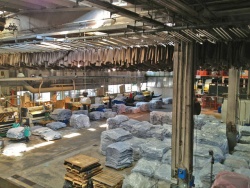
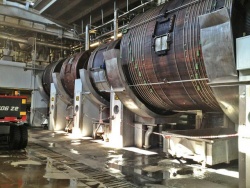
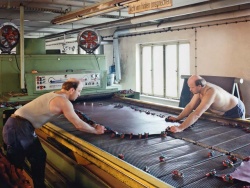
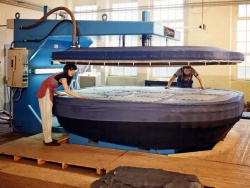
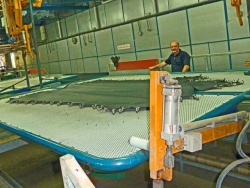
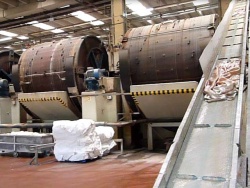
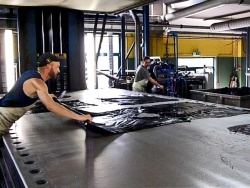
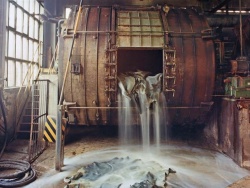
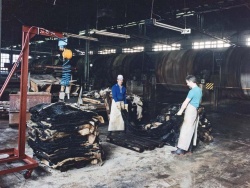
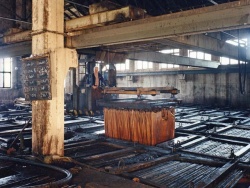
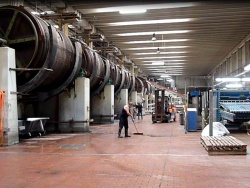
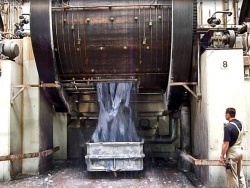
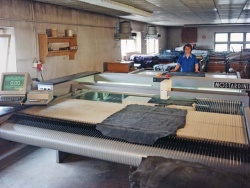
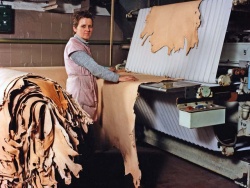

 a kotori web solution
a kotori web solution